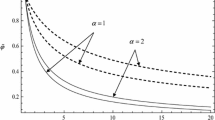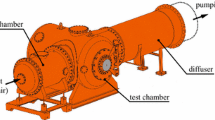Abstract
The possibility is investigated of influencing the shock wave configuration in a xenon plasma flow at the inlet of a supersonic diffuser by applying electric and magnetic fields. Flow patterns resulting from interaction of the plasma with external fields in the entire diffusor volume and its different sections are compared. The patterns are obtained by the Schlieren method using two recording regimes: individual frames or a succession of frames. The study focuses on the normal shock wave formation process under strong MHD interaction over the whole diffuser volume. Basic factors affecting the plasma flow velocity in the diffuser under externally applied fields are compared, namely, the ponderomotive force and the Joule heating of the gas by the electric field, which decelerate the supersonic flow, and the heat removal to the external electric circuit producing the opposite effect. It has been shown that the external fields are most effective if applied to the inlet part of the diffuser, while the flow in the diffuser section, where there is a large density of dissipative structures, is not readily responsive to external factors. It is suggested that the measure of response can be estimated by the energy that goes to the shock wave formation as a result of the flow interaction with the diffuser walls.
Similar content being viewed by others
References
S. V. Bobashev, R. V. Vasil’eva, E. A. D’yakonova, et al., Pis’ma Zh. Tekh. Fiz. 27(2), 63 (2001) [Tech. Phys. Lett. 27, 71 (2001)].
S. V. Bobashev, E. A. D’yakonova, A. V. Erofeev, et al., in Proceedings of the 2nd Workshop on Magneto-Plasma-Aerodynamics in Aerospace Applications, Moscow, 2000, p. 64.
V. L. Fraishtadt, A. L. Kuranov, and E. G. Sheikin, Zh. Tekh. Fiz. 68(11), 43 (1998) [Tech. Phys. 43, 1309 (1998)].
E. P. Gurijanov and P. T. Harada, AIAA Pap., No. 96-4609 (1996); in Proceedings of the 7th Aerospace Planes and Hypersonic Technology Conference, Norfolk, 1996.
S. V. Bobashev, E. A. D’yakonova, A. V. Erofeev, et al., AIAA Pap., No. 2000-2647 (2000).
L. A. Vulis, A. L. Genkin, and V. A. Fomenko, Theory and Calculation of Magnetohydrodynamic Stream in Channels (Atomizdat, Moscow, 1971).
R. V. Vasil’eva, A. V. Erofeev, et al., Zh. Tekh. Fiz. 57(2), 251 (1987) [Sov. Phys. Tech. Phys. 32, 150 (1987)].
Yu. P. Golovachev, Yu. A. Kurakin, A. A. Schmidt, and D. M. Van Wie, AIAA Pap., No. 2001-2883 (2001).
Author information
Authors and Affiliations
Additional information
__________
Translated from Zhurnal Tekhnichesko\(\overset{\lower0.5em\hbox{$\smash{\scriptscriptstyle\smile}$}}{l}\) Fiziki, Vol. 72, No. 4, 2002, pp. 23–31.
Original Russian Text Copyright © 2002 by Lapushkina, Bobashev, Vasil’eva, Erofeev, Ponyaev, Sakharov, Van Wie.
Rights and permissions
About this article
Cite this article
Lapushkina, T.A., Bobashev, S.V., Vasil’eva, R.V. et al. Influence of electric and magnetic fields on the shock wave configuration at the diffuser inlet. Tech. Phys. 47, 397–405 (2002). https://doi.org/10.1134/1.1470584
Received:
Issue Date:
DOI: https://doi.org/10.1134/1.1470584




